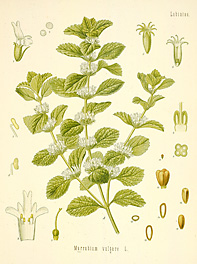Hoary Horehound
By Audrey Stallsmith

D.S.G, Bed 52, wants a good book; has a sore, weak throat; would like some horehound candy.
Civil War Poetry and Prose, Walt Whitman
Not long ago a reminiscing relative couldn’t remember the name of the candy his mother had given him for colds. When I suggested it might have been horehound, he reacted with horror. Obviously he had tasted horehound in his day—and hadn’t been impressed!
Although I must admit that it does have a musky flavor, I was fond of white horehound (Marrubium vulgare) back when I had a more extensive herb garden. In fact, I went so far as to make my own candy from the plant once. That happened to be the day a new insurance man was making his rounds. From the wary look he gave me when I explained my task, I suspect he thought me the modern equivalent of a witch.
If that was true, I wouldn’t have been growing white horehound, one of the virtuous herbs that supposedly resisted black magic, and was for thousands of years the sovereign remedy for colds, asthma, and other respiratory problems. It was even brewed into a nonalcoholic ale, probably somewhat similar to root beer. Some children liked horehound drops so well that they would buy the candy even when they didn’t have colds.
Originating in the Middle East, the plant shortly spread over much of Europe. Its name may have derived from Horus, the Egyptian God of light, or possibly from the Old English hare-hune, which combines hara (“hoary”) and hune (“honey”). The genus name could have come from an ancient Italian town called Mariaurbs or from marrob, the Hebrew term for “bitter juice,” as horehound may have been one of the bitter herbs of Passover. A member of the mint family, it usually grows about 18 inches tall with cute crinkly and fuzzy leaves.
The early settlers thought so much of the plant that they brought it with them to America. Despite its long and esteemed history, the FDA pronounced the herb ineffective in 1989 and banned its being advertised as a cough remedy. As Michael Castleman remarks in The Healing Herbs, “The FDA order removing horehound from cough and cold remedies may say more about the watchdog agency’s shortcomings than it does about the herb’s.”
In The Green Pharmacy, James Duke writes, “Commission E [the German equivalent of the FDA] endorsed horehound for bronchial complaints, so why did the FDA declare it ineffective against coughs? Beats me."
It beats me too. Many of us prefer herbal remedies because, when they are used correctly, their action is gentler than that of chemical cures. I had to stop taking modern decongestants years ago because they always made me lightheaded. I don’t recall ever experiencing any side effects from my old-fashioned candies, that were soothing in more ways than one.
Marrubium vulgare image is from Kohler's Medizinal-Pflanzen, courtesy of the Missouri Botanical Garden.








